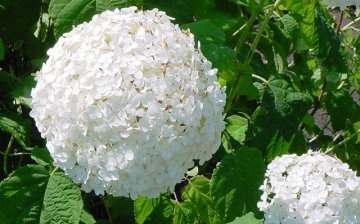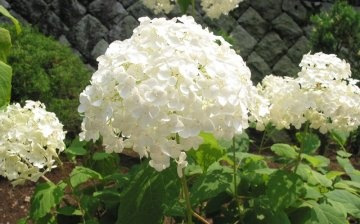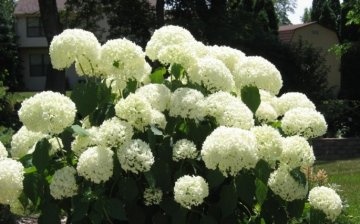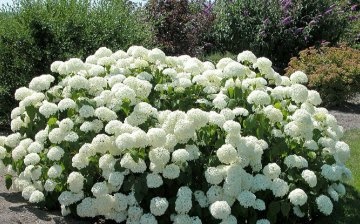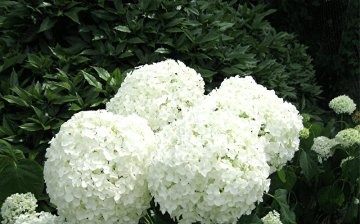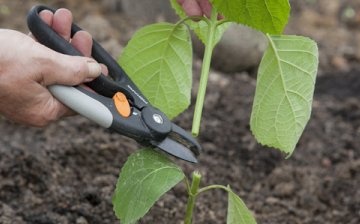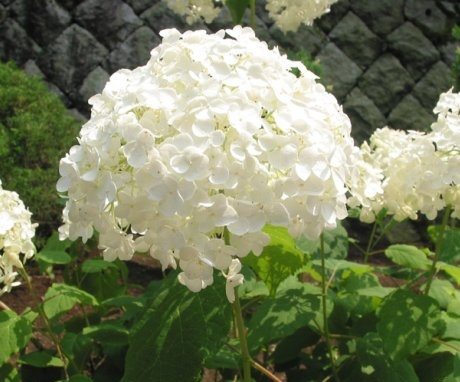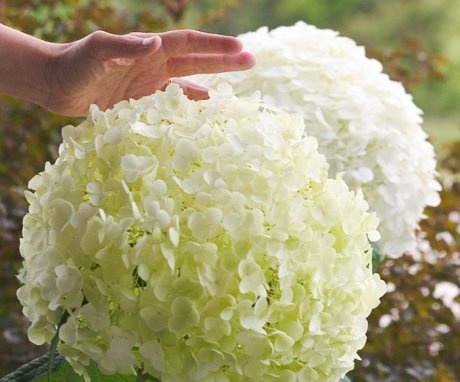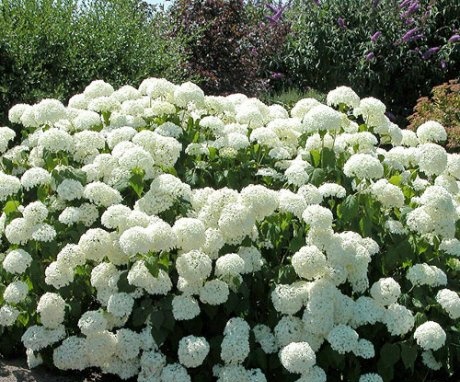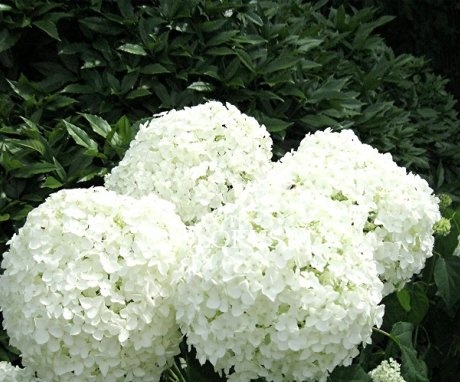Tree hydrangea: planting methods and plant care rules
The tree-like hydrangea variety will give the flower garden a pleasant contrast and will look great both as a single plant and as an addition to the overall floral arrangement. In combination with roses, clematis or lilies, the flower will look especially luxurious. The plant can also complement the tree-shrub composition, decorating the landscape.
Content
- Description of tree hydrangea
- Varieties of tree hydrangea
- How to plant a plant?
- How to care for a shrub?
- How to prune a hydrangea
- We send hydrangea for wintering
- Plant propagation
Description of tree hydrangea
Treelike hydrangea is an amazing flower. It grows up to three meters in height, has oval-shaped leaves up to twenty centimeters long. Small flowers are collected in luxurious lush inflorescences. The cold endures medium, in winter it can freeze, and in spring it can recover again and delight summer residents with a magical appearance all summer long. For this form of hydrangea, pruning almost at the root is necessary every spring in April, this is necessary so that the flowers remain in excellent shape. The flower pleases with the beauty of flowers until late autumn. This species is one of the most popular among the Hortensia genus.
It takes its roots from the north of America. Looks like straight bush with white flowers, collected in inflorescences, reaching 25 centimeters and having the shape of a hemisphere or shield. Treelike hydrangea grows quickly and is extremely unpretentious. In the 18th century, it was noticed for its showiness and luxury.
The tree-like subspecies, like all hydrangeas, does not like dry, strongly acidic and infertile soil.
Only a small amount of lime can be tolerated by this flower. From the beginning of June to the end of September, the shrub is covered with white inflorescences, acquiring a light green hue by the end of the season. The flowers do not fade for a long time, retain both their shape and color, so they can be easily used to create ikebana.
Variety characteristic:
- The tree variety is a shrub plant up to three meters high.
- A striking distinctive characteristic of this subspecies is a rounded crown, pubescent shoots.
- Another interesting feature is the bi-color of the leaves. Below, the leaves have a bluish tint, and above - a shade of green.
- In the inflorescences there are two types of flowers: sterile and fertile. The first are large flowers, up to two centimeters in diameter, but they are in small numbers, the second, that is, fertile, more, only they are small and collected in thyroid inflorescences. Their diameter can be equal to fifteen centimeters.
- The fruits of the shrub look like a small (up to three millimeters) box.
- In the fourth year of life, the plant begins to bloom. Treelike hydrangea blooms for a long time, the flowering period from June to October ends with the ripening of the fruits. It starts in October.
Frost resistance makes this species especially popular. The plant can withstand even thirty-degree frost.Even frozen branches, like a phoenix, are being restored. Next year they will give you a beautiful cloud of white flowers.
Varieties of tree hydrangea
Popular varieties of tree hydrangea:
- The first is called Annabelle. This plant is shaped like a dome, sometimes reaching three meters in height. The inflorescences are so heavy that the weak shoots are pressed to the ground. The subspecies is famous for light-green balls-inflorescences, which eventually become snow-white. In addition, there are breeding varieties with other colors. This hydrangea, like many subspecies of the plant, is characterized by a very long flowering period - from early summer to mid-autumn.
- The second variety of tree hydrangea is called "Incredibol". This variety was bred quite recently. The species is distinguished from other varieties by the presence of large and lush white inflorescences, the diameter of which can reach thirty centimeters. Icredibol blooms from June to September. It grows in height up to one and one and a half meters.
Planting and caring for these types of colossal efforts does not require at all.
How to plant a plant?
The best thing plant hydrangea in spring, just at the moment when the soil thaws, and the buds on the trees begin to bloom. The planting pit should not be deeper than fifty centimeters. But if the root system does not fit, then deeper depressions are permissible. In addition, if the soil is infertile, then the hole should be dug more.
Before planting a plant, peat or humus must be poured into the hole, not forgetting to fertilize with fifty grams of mineral fertilizers.
Be sure to cut off damaged stems and leaves, if any. Spread the root outgrowths in opposite directions. When planting, the root collar should not be deepened more than three centimeters. Tamp the soil well, otherwise voids will form and the roots may begin to dry out.
After planting the plant, water it abundantly. Good watering is necessary for moisture to saturate the soil up to forty centimeters deep. Of course, planting a plant well is very important, but an equally important point should not be missed - caring for a hydrangea.
How to care for a shrub?
The mulching process is one of the most important in hydrangea care. What is this stage of care for? It is needed to avoid overheating the flower, to remove weeds from it - the inveterate enemies of any inhabitant of the flower garden.
Hydrangeas are very fond of acidified soil.
To do this, during mulching, you need to add an even layer of peat, which is about ten centimeters. The soil warms up and is still sufficiently moist in May, which is why this procedure takes place at the end of spring. except mulching hydrangea tree regular and timely feeding is necessary. This is necessary for the showiness of the flowers and the good development and growth of the shrub. At the very beginning of spring, gently loosen the soil.
Feeding hydrangeas:
- Before mulching the flower, sprinkle complex fertilizers near the plant, you need a little - just a handful. You can use "Kemira-flower". This top dressing will provide not only macronutrients, without which the shrub cannot develop normally, but also a whole group of basic micronutrients.
- Feed a tree variety hydrangeas are needed a second time during the budding period. In this case, only potassium and phosphorus (about fifty grams) and about twenty-five grams of potassium sulfate are needed for feeding.
- Manure or fertilizers are also good for tree hydrangeas. Young bushes can be fed three times during the summer. Only the dose of fertilizers should be slightly less.
- Be careful with nitrogen-containing fertilizers, as too much during the bloom period will result in a greenish color.In addition, hydrangeas, overfed with nitrogenous fertilizers, tolerate winter much worse.
- Better sometimes pour the hydrangea with sour milk or kefir. Slices of bread soaked or sour in milk will be a good top dressing.
Throughout the spring, it is necessary to water the tree hydrangea three times with a weak solution of potassium permanganate. It is necessary to pour not only at the root, but also on the crown. Such feeding will strengthen the strength of the shoots of the shrub, because the inflorescences are sometimes very, very large, and a strong wind or rain can cause the shoots to break off, they can lie on the ground.
Some summer residents tie up a hydrangea, but, you see, it does not look as beautiful and impressive as a bush that freely scattered its strong branches.
How to prune a hydrangea
After a year of life in a tree variety of hydrangeas at the top, wide and dense inflorescences-shields are formed, which consist of a large number of white flowers.
Recommendations for pruning hydrangea tree-like:
- An adult who has lived more than four years, the hydrangea is pruned in early spring, in March. It is necessary to cut from ten to twenty centimeters in order for the shrub to become thicker and bloom more elegantly, to give large inflorescences. If the shoots are not cut off, the inflorescences will be too small. One-year-old shoots can be cut by a third, but only on an adult bush.
- Young shrubs of hydrangea tree-like (up to four years old) should not be pruned in March and the crown should not be formed by pruning before reaching four years. In the spring, hydrangea experiences a very strong sap flow, and a weak shrub during pruning, of course, will suffer and may even die. If there is a strong need to prune a young hydrangea bush, do so after the leaves have bloomed.
If you cut off a young hydrangea, then juice will flow from the slices, which, alas, you cannot stop.
We send hydrangea for the winter
When winter comes, the plant timely care is required... Non-frost-resistant varieties should be covered first. Mulching with sawdust, a layer of peat or fallen leaves will bring good results. Non-frost-resistant varieties will appreciate your concern. Shelter must be made after frost, the weather must be dry.
If the species is thermophilic, it must be bent to the ground, carefully pinned so that the branches do not break, and covered with fallen leaves or spruce branches.
When the threat of frostbite disappears, remove the shelter. This should be done in cloudy weather, as bright sunlight can cause burns. Of all the pests, hydrangea is susceptible only to spider mites. other diseases rarely affect the flower.
The shrub is sensitive to excess lime in the soil. Excess can cause lightening of the foliage, the cause of this will be chlorosis.
Plant propagation
There are several breeding methods for tree hydrangea:
- Cuttings
- Grafting and seeds
- Dividing the bush
Use young annual shoots to root the shrub. The fastest they take root during the flowering period... Mix peat and coarse sand (two parts peat and one sand). Plant the cuttings in this mixture. Sprinkle with sand after planting. peat will contribute to soil oxidation, it is necessary for young shoots to take root. Root feeding will improve rooting. It will happen in twenty days.
Planting with seeds is quite troublesome, so this process is rarely practiced.
Hydrangea seeds are extremely small. The seeds are planted in a slightly acidic mixture of humus, sand, peat and leafy soil. Planting boxes are ideal for planting seeds. Liquid complex fertilizers are used for feeding and accelerating germination. in the fall, the bushes will reach a height of thirty-five centimeters, and in winter they will need to be covered.
You can divide the bush either in the fall or in the spring.To do this, you need to dig up the bush and divide it into several equal parts. Each should have kidneys. which are needed for the recovery processes in the plant. Remember that hydrangea is an unpretentious flower, but it also needs care and attention.
More information about pruning hydrangea trees can be found in the video.



